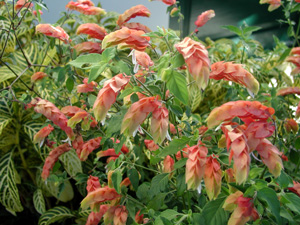Resource Library
Plant of the Week: Shrimp Plant
The University of Arkansas System Division of Agriculture does not promote, support or recommend plants featured in "Plant of the Week." Please consult your local Extension office for plants suitable for your region.
Plant of the Week
Shrimp Plant
Latin: Justicia brandegeana

Plants – like people – often get pigeon-holed and placed in a box where it is difficult to change a first impression. Shrimp plant, Justicia brandegeana, if gardeners know it at all, is often perceived as a gawky pot plant from generations gone by with little to offer the busy gardener. Not so. This tough, dependable native of Mexico native loves the heat and humidity of the South and offers much in the modern garden.
Shrimp plant is one of about 400 species of tropical American herbs belonging to the acanthus family. Several species of Justicia are cultivated with shrimp plant and Mexican plume (J. fulvicoma) amongst the most common.
Shrimp plant is a slowly spreading tropical herb capable of growing 5 feet tall in a tropical clime but when grown as an annual in the ground usually only reaches 2 feet tall and wide. It has and open and sprawling habit with round stems and widely spaced opposite leaves that are ovate in outline with an entire margin and 2 to 3 inches in length. Like most members of the acanthus family the leaf pairs alternate at right angles up the stem.
The inflorescence is produced at the ends of the branches as a cluster of tightly packed spade shaped bracts to .75 of an inch long that are salmon colored. Typically, the bract cluster is 3 to 4 inches long, but in tropical areas they will continue to elongate and can reach 10 or more inches in length. Both the color and curved and tightly packed bracts have the general appearance of a boiled shrimp tail. White, two lipped, inch long flowers protrude here and there from the bracts and are produced over an extended period. The flowers have a sweet cache of nectar at their base and are favorites of hummingbirds and butterflies. When viewed from the end, the inflorescence is square in outline.
The genus Justicia was named by Linnaeus to honor James Justice, a Scottish gardener who authored the British Gardener’s Dictionary, first published in 1754. The species name honors Townsend S. Brandegee (1834 – 1925), a surveyor, botanist and plant collector who became an expert of the flora of the Baja region of Mexico. Brandegee was part of several U.S. government survey expeditions in the western states. He was also hired during the 1880’s as a railroad surveyor in Arkansas where he collected plants and sent them to Asa Gray at Harvard. In 1889 he met and married a fellow botanist in California, and for their honeymoon, they hiked from San Diego to San Francisco.
Shrimp plant grows best in fertile, well-drained soils in full sun or light shade. It is hardy outside in zones 8 and south but freezes to the ground in winter in zones 8 and 9. It is also well suited for use as a pot plant for winter bloom so long as a sunny window is available. If used in a mixed patio planting for summertime bloom, provide a pot with ample room for the roots.
Most members of the acanthus family are moisture-loving plants that wilt quickly with the first sign of drought stress. Shrimp plant is – while not quite drought tolerant – more capable of enduring dry conditions than most of its kin. Afternoon wilting will not harm it but prolonged drought will stop flower production and can result in leaf drop.
Several cultivars are available including the dwarf selection called ‘Jambalaya’, a yellow-flowered form and one with pale pink bracts. Whiteflies and mealy bugs can become serious pests, especially indoors.
By: Gerald Klingaman, retired
Retired Extension Horticulturist - Ornamentals
Extension News - August 10, 2012
The University of Arkansas System Division of Agriculture does not maintain lists of retail outlets where these plants can be purchased. Please check your local nursery or other retail outlets to ask about the availability of these plants for your growing area.